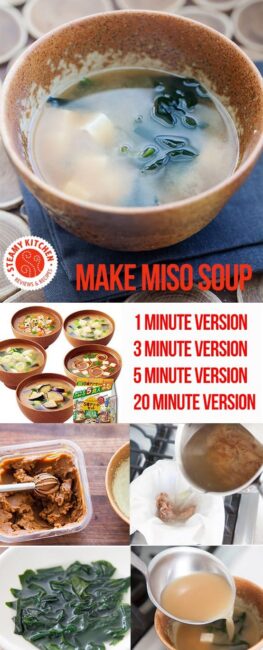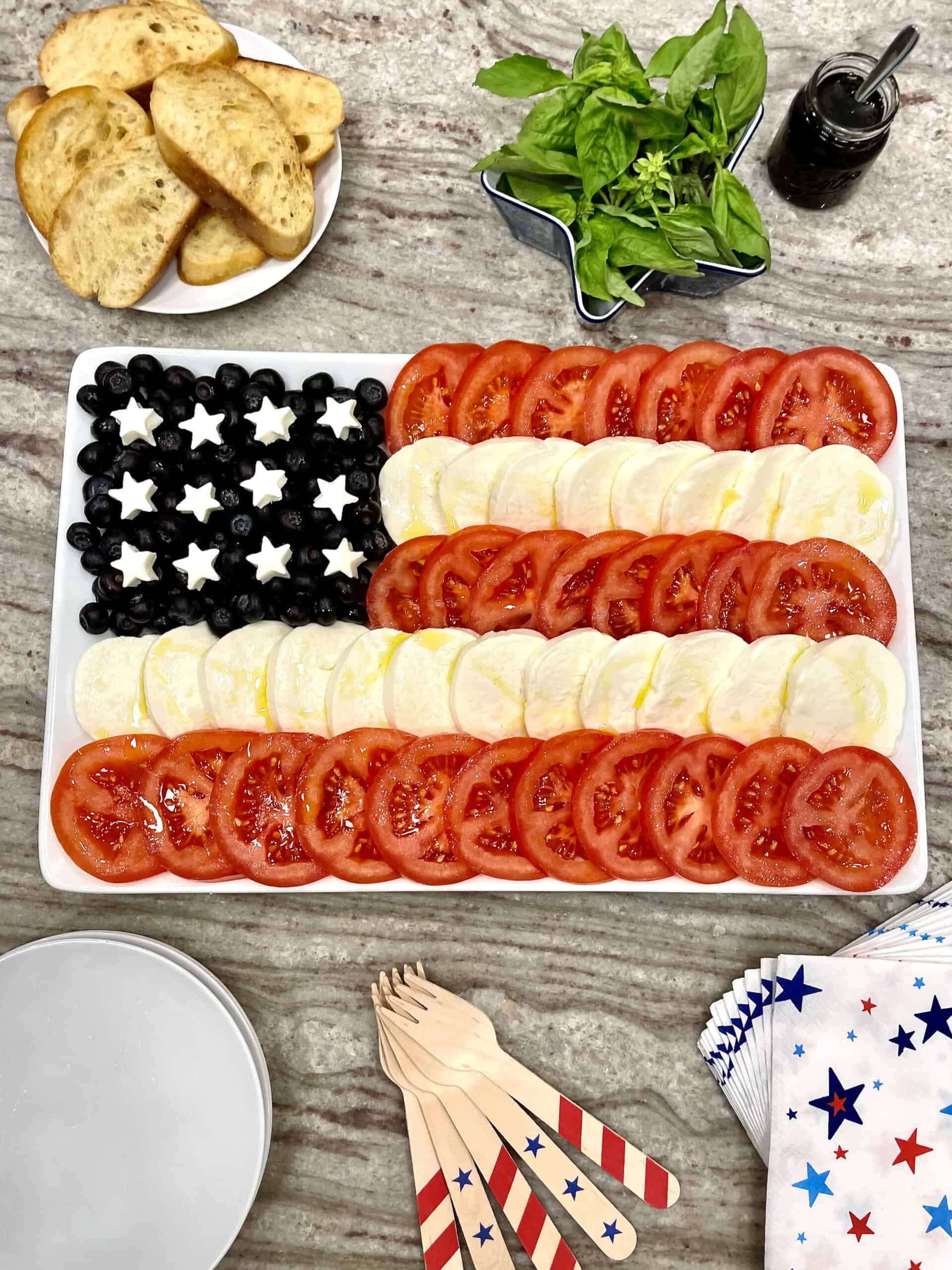posted by on November 11, 2017
You’ll learn how to make miso soup, in 4 different ways. Choose the method that fits your time available! Make miso soup in 1 minute…all the way to the authentic version with homemade dashi and miso paste. Plus, important tips on what NOT to do with the bonito and seaweed.
Here are the miso soup versions that you’ll learn how to make:
- 1 minute miso soup
- 3 minute miso soup
- 4 minute miso soup
- 20 minute miso soup (miso soup from scratch!)
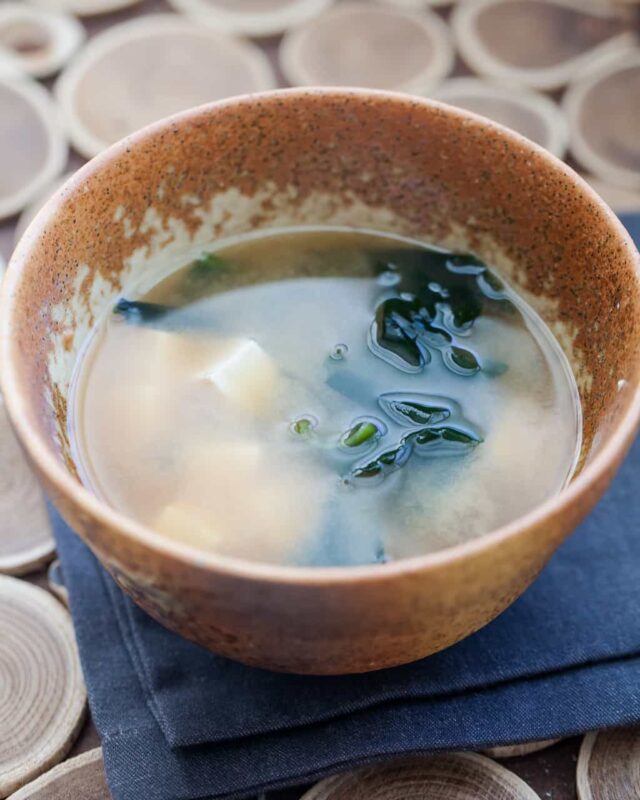
Miso Soup Ingredients
There are 2 main ingredients in any miso soup: Dashi and Miso Paste.
- Dashi is the most fundamental ingredient in Japanese cooking. It is the basis of many Japanese soups, sauces and simmering broths. Dashi is made of seaweed (kombu) and smoked & dried fish (bonito).
- Miso is made from soybeans, rice and/or barley. Salt is added and then the mixture is fermented. The result is a savory, salty, umami-rich paste that can be used to make miso soup, miso ramen, salad dressings, marinades (try Miso Salmon recipe).
After you have the basic miso soup, you can add various toppings: green onion, tofu, seaweed, mushrooms, clams, leeks, noodles and any vegetables.
So, let’s get started with the simplest way to make miso soup in a hurry.
How to make 1-Minute Miso Soup
The simplest way to make miso soup is with a ready-made mix. Inside the package, there are 3 packets of instant miso soup. Open a packet, dump the powder and freeze-dried tofu cubes into a bowl. Stir in hot water. Done!
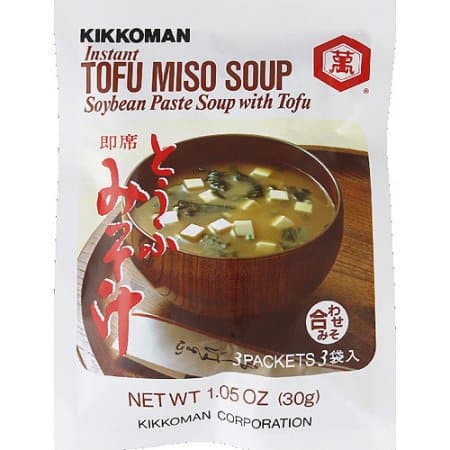
Kikkoman is the most well-known and widely available brand of instant miso soup, but it’s not the best.
If you are near an Asian market, especially one with lots of Japanese ingredients, look for a package of instant miso that contains miso paste packets, like this, from Marukome brand.

This particular package on the left contains 32 packets of instant miso (each serves 1). The one on the right has 5 servings. Both of these packages offer different miso soup toppings and flavors.
The one I have has 24 servings (see below). There are 24 miso paste packages (the smaller packets in blue), and several different toppings: tofu, green onion, seaweed, bean curd.
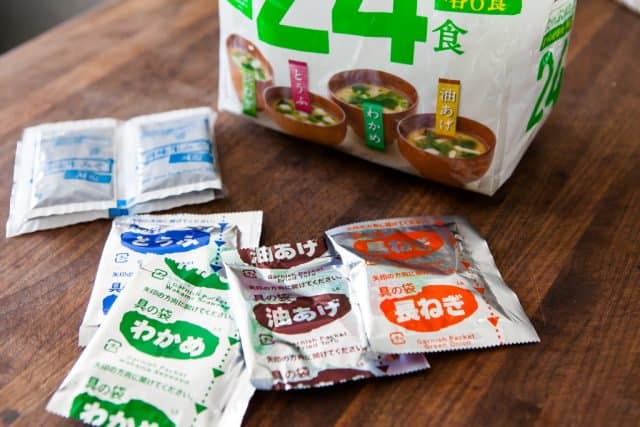
The miso paste packets are so much better tasting than the miso powder from Kikkoman!
Most of these brands have packages that are all in Japanese. If you can’t read Japanese, pick up the package. If it feels heavy, than it should contain miso paste. If the package feels relatively light, then mostly likely, the miso is just powdered.
To Make 1-Minute Miso Soup
- Microwave 1 cup of water for 1 minute.
- Mix in packet.
How to make 3-Minute Miso Soup
Making miso soup in 3 minutes only requires 1 ingredient: Miso paste that is already mixed with dashi. It looks exactly like regular miso paste, and you wouldn’t be able to tell the difference between the two, unless you read the package.
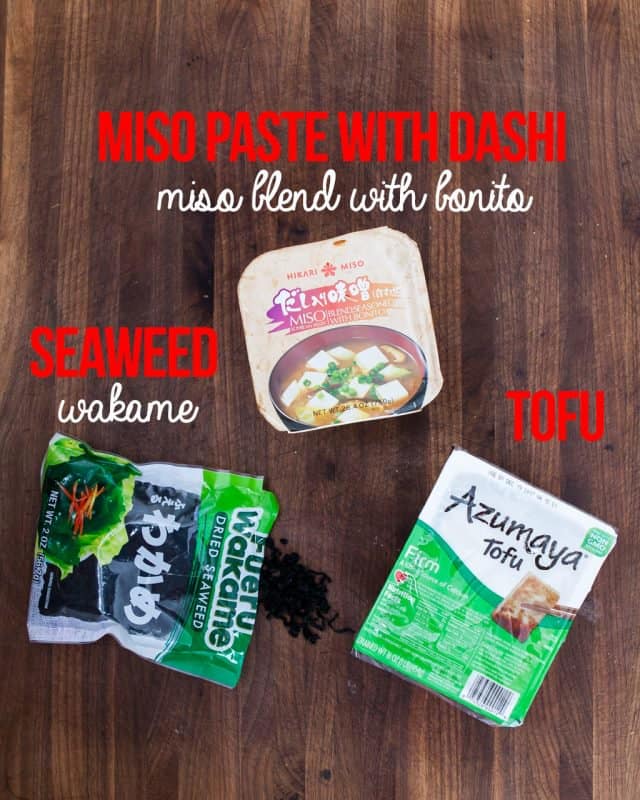
Since the dashi (or bonito) is already in the miso paste, all you need to do is whisk in with hot water for basic miso soup. Add in diced tofu and dried seaweed (wakame). Dashi is pronounced DAH-shee.
What is wakame?
Seaweed used for miso soups and salads is called wakame, pronounced wah-KAH-meh.
Wakame is sold in dried form. All you need to do is soak the dried wakame in water for a couple of minutes. Once rehydrated, it will expand!

Soak in cold water for 5 minutes, or hot water for 1 minute. Drain, and then add to miso soup. All you need is just a pinch of dried wakame for each bowl. You’ll be surprised how much it expands! This was 1 teaspoon of dried wakame:
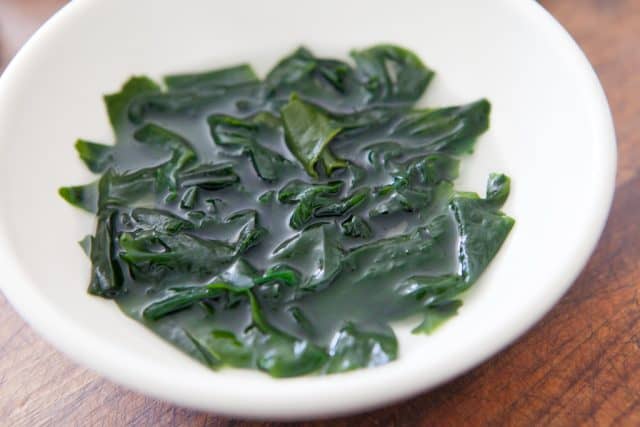
To make 3-Minute Miso Soup:
- Soak wakame in water, drain.
- Cut up tofu into small cubes.
- Boil water, turn off heat. (or microwave 1 cup water for 1 minute)
- Whisk miso/dashi paste into hot water.
This nifty tool is a miso tool. It not only measures out miso paste, but it also serves as a whisk. One end is 1 teaspoon, the other end is 1 tablespoon. For 1 small bowl of miso, I use 1 teaspoon of miso/dashi paste. For stronger tasting miso soup, you can use 1 tablespoon. But I like my miso soup on the light side.
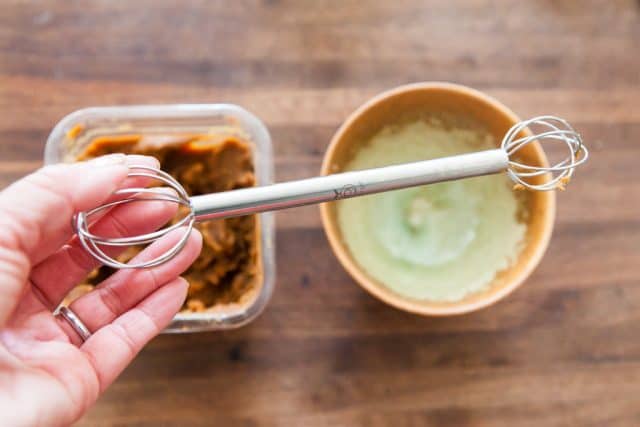
Stick the miso tool into the miso paste and twist a bit. The perfect amount of miso will end up in the whisk!
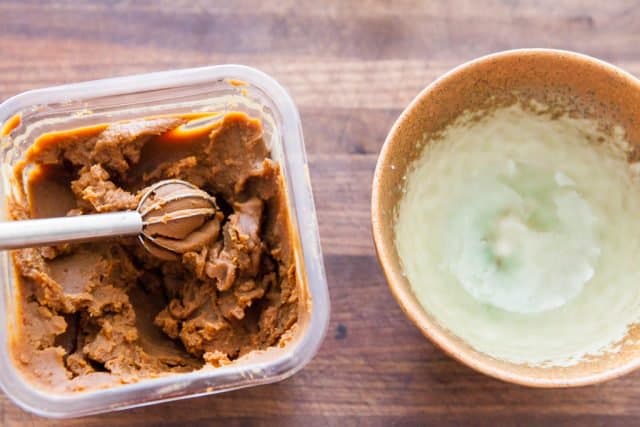
Just whisk in the hot water. As you whisk, the miso will dissolve.
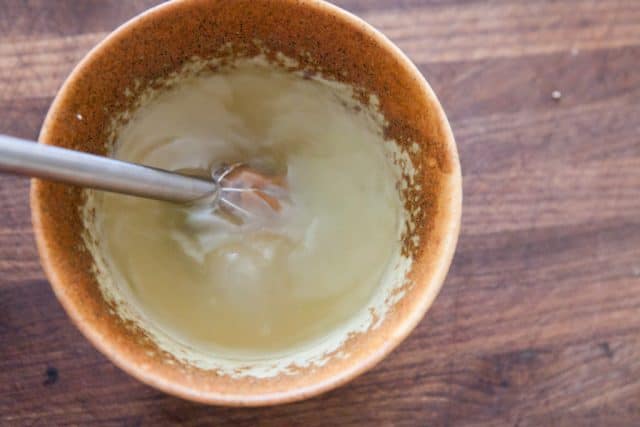
Add in the tofu and drained wakame.
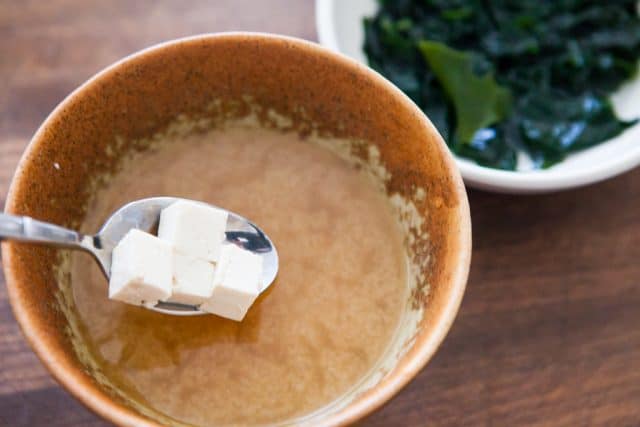
Miso soup is ready in just 3 minutes.
How to make 4-Minute Miso Soup
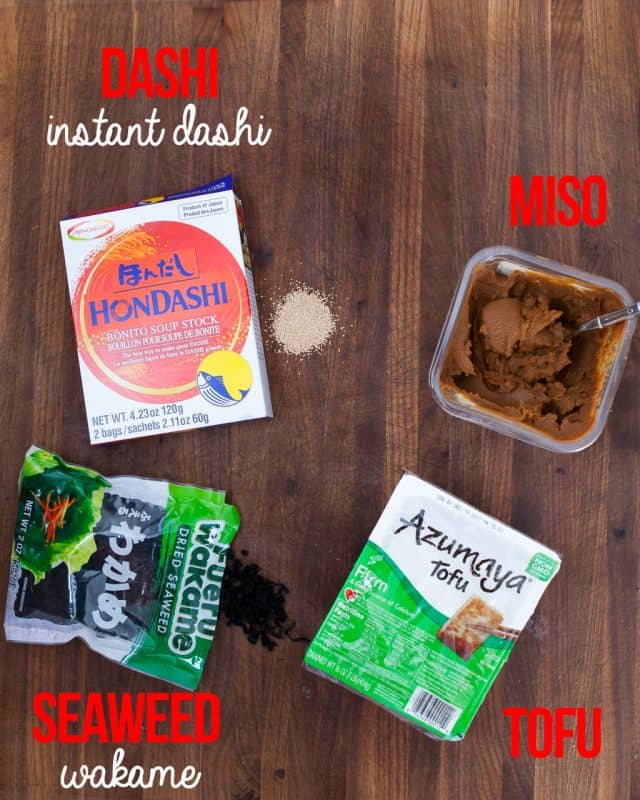
Another version of fast miso soup uses instant dashi, in the form of little granules. Think of it as Japan’s version of chicken bouillon. Very little instant dashi is used: 1 teaspoon for every 2 cups of water.
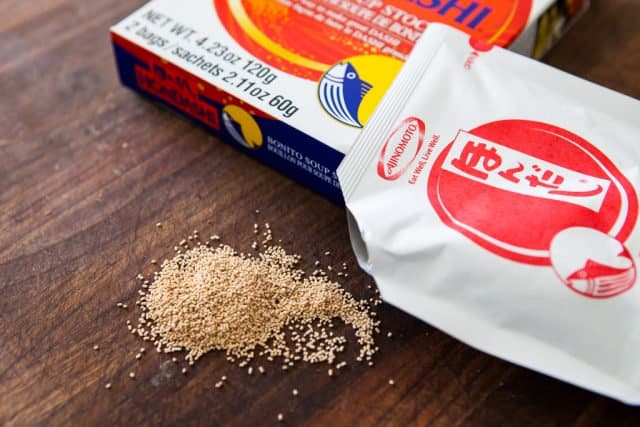
There is MSG in instant dashi, but very little instant dashi is used in miso soup. Personally, I’m very sensitive to MSG, but using this instant dashi (especially this brand called Hondashi) does not affect me at all.
Other uses for instant dashi: When boiling or blanching vegetables, I’ll add a teaspoon to the cooking water for an extra boost in flavor. I love adding instant dashi to the water when I’m boiling edamame to snack on.
To make 4 Minute Miso Soup
- Cut up tofu.
- Soak wakame, drain.
- Boil water, turn off heat.
- Whisk in instant dashi (1 teaspoon: 2 cups water)
- Whisk in miso paste (2 tablespoons: 2 cups water)
How to make 20 Minute Miso Soup: Miso Soup from Scratch
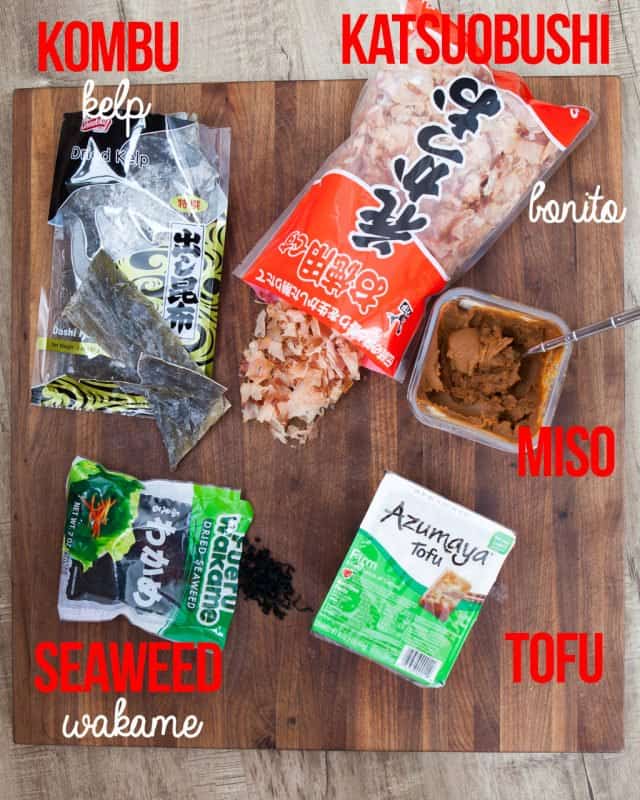
To make miso soup from scratch, you’ll need to make dashi, which is a combination of kombu (large, dried seaweed/kelp) and katsuobushi (smoked, dried skipjack tuna fish shavings).
What is Kombu?
Kombu is sold dried, in large pieces or sheets. Kombu is cultivated in Hokkaido (northernmost island in Japan), Korea and China. It adds loads of umami flavor with its natural glutamates. No MSG is needed when you use kombu!

If you’re making a pot of miso soup for 4 people, you’ll need a piece of kombu approximately 4″x6″ size.
Gently wipe the kombu with a dry cloth or paper towel, to wipe away any dirt. Don’t try to wipe away the white powder on the kombu, which is natural crystalized minerals and provides flavor and nutrients to your dashi stock.
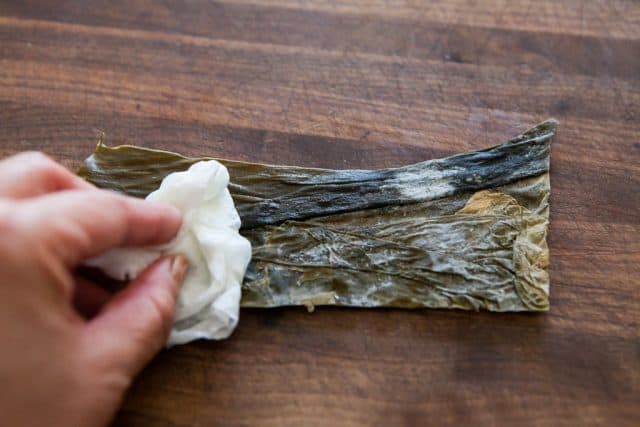
What is Katsuobushi?
Katsuobushi is made from skipjack tuna (bonito) that is smoked, dried, then shaved into ultra feather-light pieces.
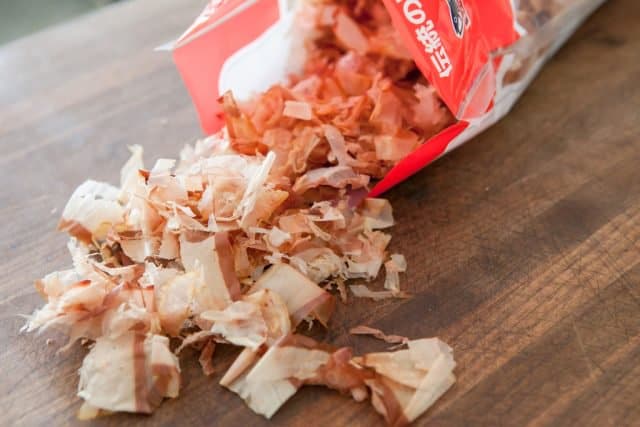
To make dashi from scratch
Add a 4″x6″piece of kombu to cool water. Turn heat to medium-low and bring to a boil. Keep the heat medium-low!
Note: for best flavor, you can soak the kombu for 30 minutes or up to overnight in cool water before bringing to a boil. But, if you’re making miso soup in 20 minutes, there’s no need to soak for more than a couple of minutes…which is the time it takes to bring the water to a boil.
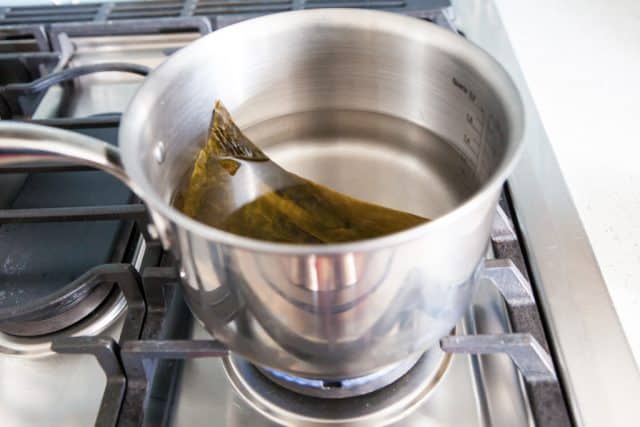
When the water is just about to boil, remove the kombu.
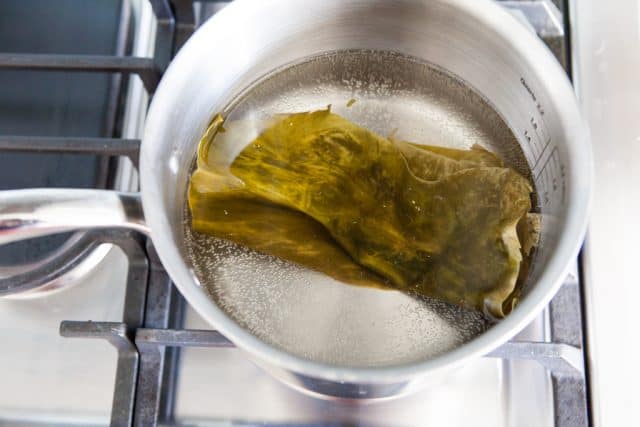
Don’t boil the kombu! Boiling kombu will make the dashi cloudy and strong smelling. Just remove the kombu when you see little bubbles coming up to the surface of the water.
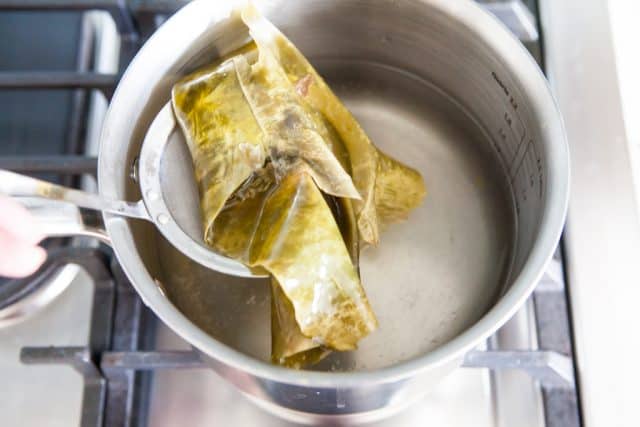
Don’t discard the used kombu! Just put on a clean plate, and let dry. You can re-use kombu to make another batch of dashi (secondary dashi), or cut up and eat. There is a ton of nutrition in the kombu!
After removing the kombu, bring the water to a boil. Once the water is boiling, add a handful of katsuobushi.
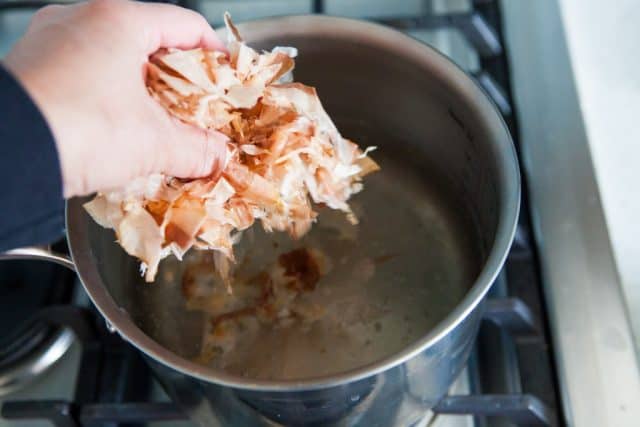
Boil for a minute.
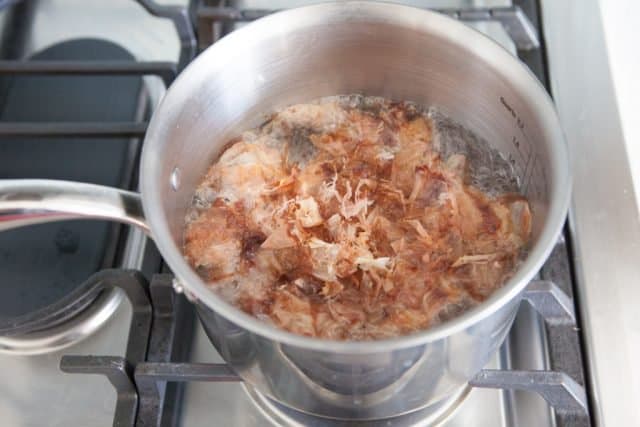
Then turn off the heat, and let the bonito sit, undisturbed to steep for 10 minutes. If you boil the bonito for too long, the dashi will smell very strong (fishy).
After a couple of minutes, the katsuobushi will naturally sink to the bottom. Do not stir the bonito! If you stir the bonito around, the dashi will become cloudy.
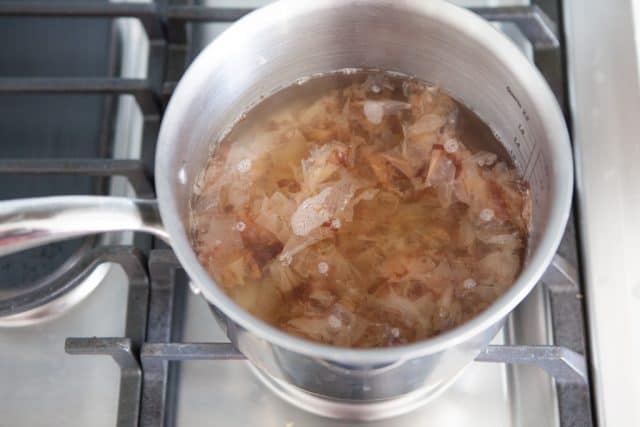
Once all the katsuobushi has sunk to the bottom, strain the katsuobushi out. It’s best to pour the dashi through a fine mesh strainer and cheesecloth or clean hankerchief.
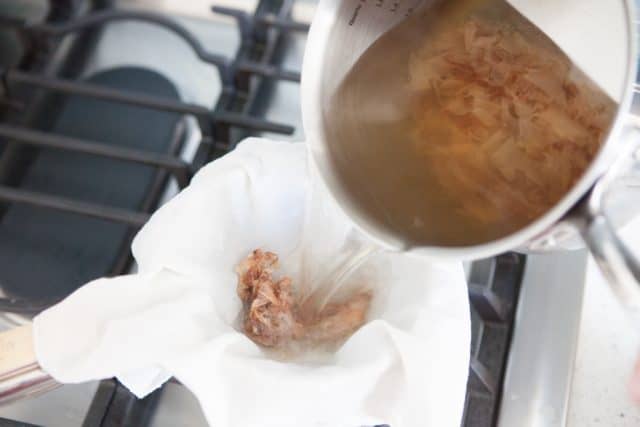
Sure, you can use a fine mesh strainer to fish out the katsuobushi, but it will take a long time, and in the process you risk stirring up the katsuobushi too much (causing the dashi to become cloudy).
The spent katsuobushi (along with the used kombu) can be re-used to make secondary dashi, which is a weaker tasting dashi that can be used for many Japanese dishes. Just simmer the katsuobushi and kombu for 10 minutes, then strain.
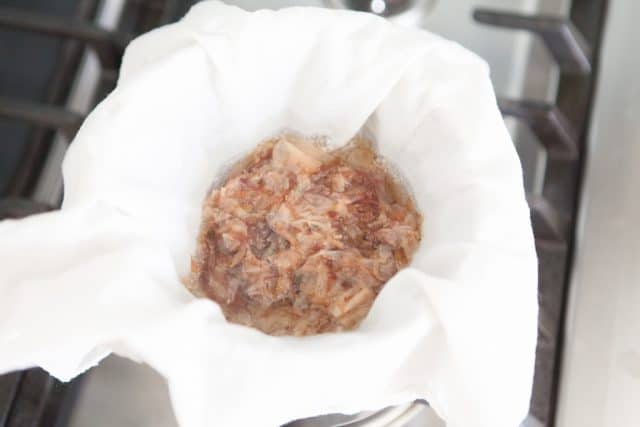
Dashi complete!
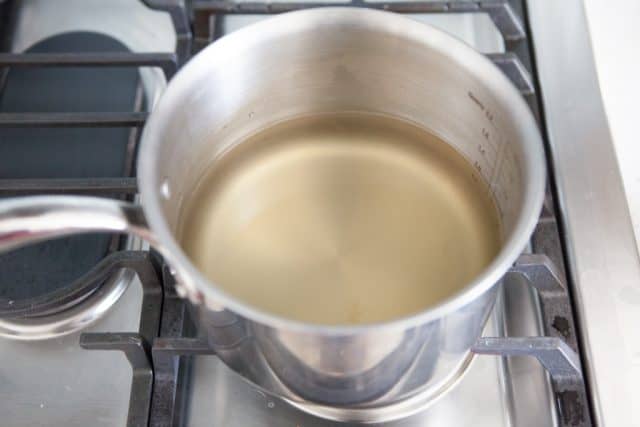
Bring the dashi to a boil. Then immediately turn off the heat to whisk in the miso paste. Do not boil the miso paste, which will make the miso soup gritty, and destroy the probiotics found in miso.
We’re making miso soup for 4 people, so I like to use about 3 tablespoons of miso paste. If you don’t have a small miso whisk (in the 3-Minute Miso Soup section), just use a regular whisk and grab about 3 tablespoons of miso. No need to be exact. You can taste the soup and add more, if needed.
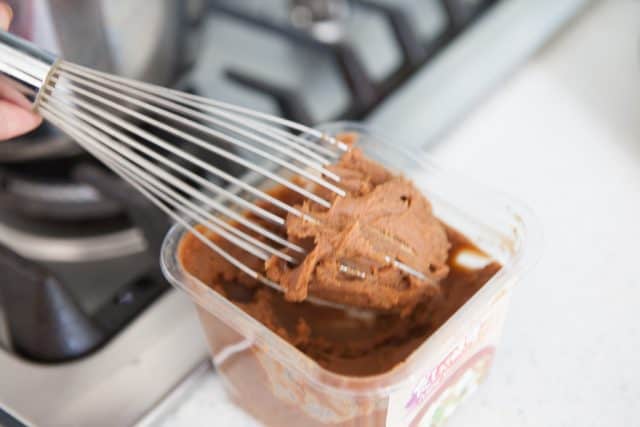
Whisk the miso directly into the dashi stock.
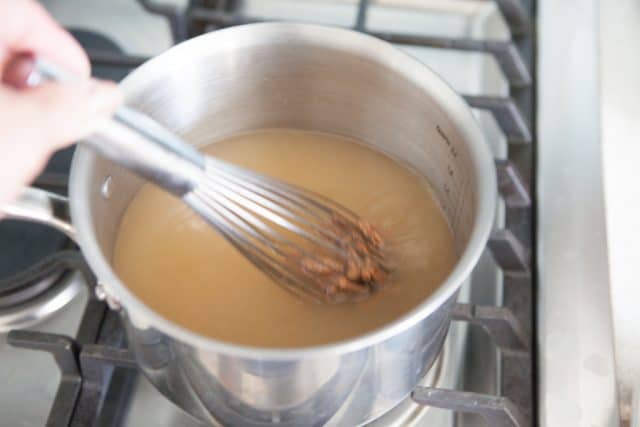
After all the miso has dissolved, you can add tofu and wakame to the pot, or just add them to the bowls and ladle miso soup into each bowl.
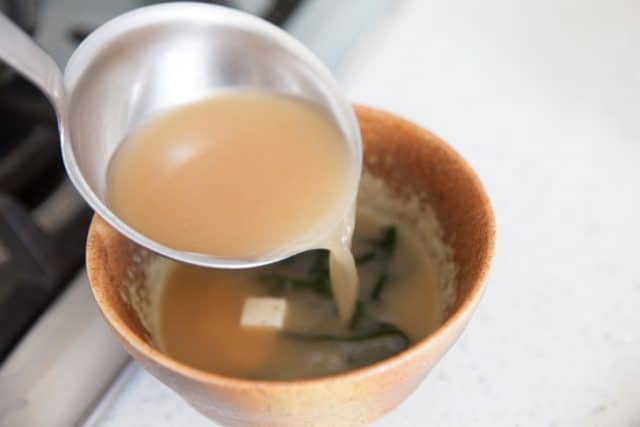
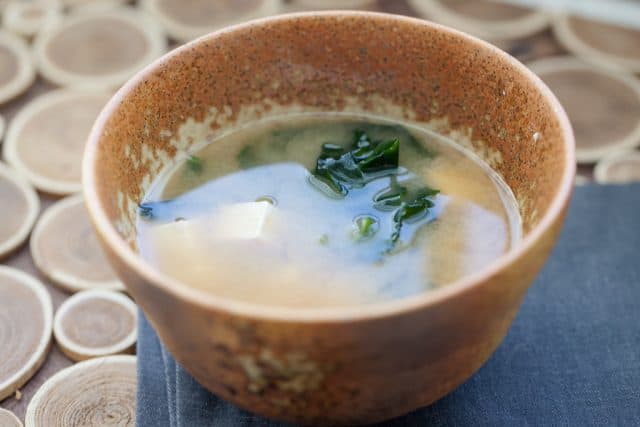
About Miso Paste
There are many different types of miso paste that you can use for this miso ramen recipe. You can lump them into 3 different categories: White, Yellow and Red.
- White miso (shiro) is made from fermented soybeans and rice. It’s the mildest and sweetest miso.
- Yellow miso (shinsu) is made from fermented soybeans and barley. It’s fermented longer than white miso, and is saltier.
- Red miso (aka) is made from fermented soybeans and most often, barley. It is the most salty, strong tasting miso.
White miso, or shiro miso is my favorite. It’s lighter and less salty than the other kinds of miso. I love the delicate flavor! We use this for our Miso Salmon recipe. I find that the red miso is too strong for my palate.
Not only do I use white miso for making Japanese style noodle soups, but if I’m making any kind of soup that needs a kick of flavor, I’ll stir in a big tablespoon of miso paste, which is a natural umami-master. It will add a savory, salty, slightly sweet flavor boost to anything! (Pssst….I even add it to mashed potatoes!)
There’s also miso that has dashi mixed into the paste…which is what we used for the 3-minute miso recipe above. Look at the package very carefully, it will say one of these things:
- Seasoned Miso
- Miso with Bonito
- Miso with Dashi
Most miso paste in stores are sold in plastic tubs or plastic bags. I prefer the tubs, because miso paste can be stored in the refrigerator for up to 6 months, it is easier to store in the tub.
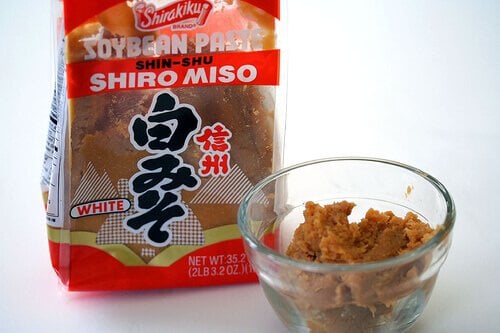
To store miso paste, press plastic wrap directly over the miso. Try to cover the miso so that air does not dry out the paste.
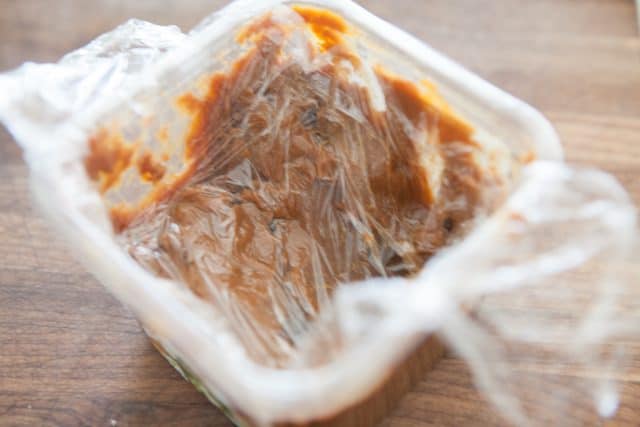
Cover with lid and refrigerate. Store properly, miso should last about 6 months in the refrigerator.
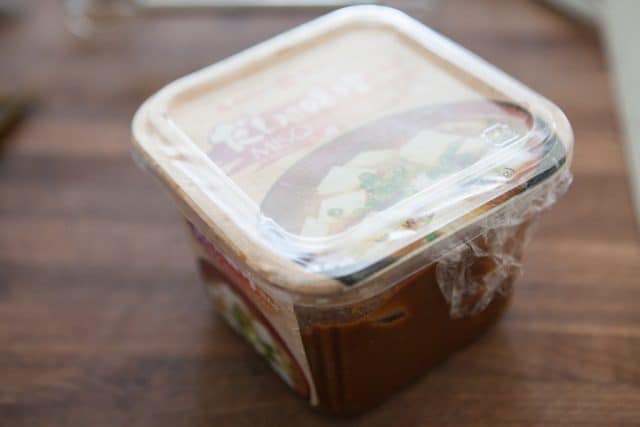
More recipes that use Miso Paste
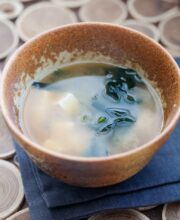
This is the recipe to make miso soup with homemade dashi.
Course: Side Dish
Cuisine: Japanese
Servings: 4 people
Calories: 67 kcal
:
- 4 cups water
- 1 piece kombu 4″x6″ piece kelp
- 1 ounce katsuobushi bonito flakes
- 3 tablespoon miso paste
- 4 ounces tofu
- 1 tablespoon dried wakame seaweed
-
Wipe the kombu clean with a paper towel. Add the kombu and water to a sauce pan. Bring to a boil over medium-low heat. When water just begins to boil, remove the kombu.
-
Bring the kombu water to full boil. Add the katsuobushi all at once. Boil for 60 seconds. Turn heat off and let sit, undisturbed for 10 minutes.
-
in the meantime, dice the tofu. Soak dried wakame in water until expanded. drain and discard water.
-
After steeping katsuobushi, the flakes will sink to bottom of pot. Strain the katsuobushi through cheesecloth.
-
Return dashi to a simmer and immediately turn off heat. Whisk in miso paste. When miso has fully dissolved, add tofu and wakame.
Nutrition Facts
Miso Soup from Scratch
Amount Per Serving
Calories 67 Calories from Fat 9
% Daily Value*
Total Fat 1g 2%
Cholesterol 4mg 1%
Sodium 529mg 22%
Potassium 143mg 4%
Total Carbohydrates 4g 1%
Sugars 1g
Protein 8g 16%
Calcium 2.4%
Iron 3.4%
* Percent Daily Values are based on a 2000 calorie diet.
